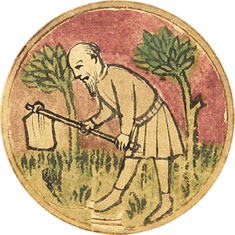Recursos

Llibre del Sindicat Remença de 1448
The remences (serfs)

The remences (serfs) were men and women who were tied by contract to a country house and its estate, and were obliged to pay a redemption fee to liberate themselves from this assignment to the land. This obligation to live on the estate was accompanied by other types of bondage -known as "seigniorial abuses" (mals usos)- and obligations that the peasant owed to his master. The serfs were also known as homes propis, solius i afocats (belonging to the lord and tied to the land).
The lord could keep part of their land if they died childless or without leaving a will (eixorquia and intestia); he could also lay claim to it if their farmhouse burnt down (àrsia). He also had the right to receive part of the remença's assets when he got married (ferma d'espoli forçada) and to punish him if his wife was found guilty of adultery (cugúcia).
The monarchy was ambiguous and hesitated over the peasants' petitions. Its first steps in favour of the abolition of the seigniorial abuses contrast with the strategies to avoid losing the favour of the important feudal lords. It was the House of Trastàmara with Alfons IV, and above all his wife, Queen Consort Mary, who took the most decisive steps in favour of the serfs.
During the reign of John II took place the Peasant's Revolt of 1462, which along with other forms of social discontent, resulted in the War of the Remences from 1462 to 1472. In 1482 there was a new uprising, resulting in the drafting of the Guadalupe Arbitral Ruling, decreed by Ferdinand II on 21st April 1486. The Guadalupe Arbitral Ruling established the abolition of the seigniorial abuses, despite preserving the rights of lords over the peasants. It also stipulated compensation to the lords -for war damage- and a fine for the peasants that had revolted.
Would you like to find out more?
- "Remences", Diccionari d'Història de Catalunya. Barcelona: Edicions 62, 1992.
- Julià de Chia, Bandos y bandoleros en Gerona. Apuntes históricos desde el siglo XIV hasta mediados del XVII, Girona (1888).
- J. Fernández Trabal, "El conflicte remença a la Catalunya del segle XV (1388-1486)", Afers, 42/43 (2002), p. 587 – 624.
- P. Freedman, The originis of Peasant Servitude in Medieval Catalonia, Cambridge University Press, 1991. In this work Freedman links the document mentioned by Chía with that which Vives asks for and analyzes in the prologue, pp. 190-192.
- M. M. Homs i Brugarolas, El sindicat remença de l'any 1448. Barcelona: Fundació Noguera – Ajuntament de Girona, 2005.
- R. Lluch i Bramon, Els remences. La senyoria de l'Almoina de Girona als segles XIV i XV. Girona, 2005.
- J. Vives Vives, Historia de los remensas (en el siglo XV). Barcelona: 1645 (reed. Ediciones Vicens-Vives, 1978.
- J. Vices Vives, El gran sindicato remensa (1488-1508), Madrid: Consejo Superior de Investigaciones Científicas, 1954. It is in this work, on p. 105, that the author notes the importance of finding the documentation related to the Peasant Syndicate of 1448.
- S. Sobrequés Vidal, Política remensa de Alfonso el Magnánimo en los últimos años de su reinado. Annals de l'Institut d'Estudis Gironins, 1960, Vol. 14, p. 117-154.

